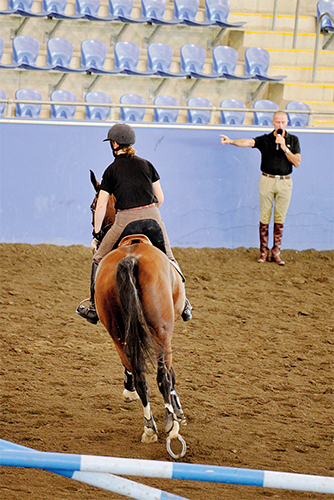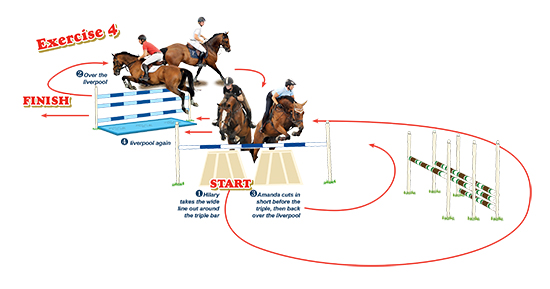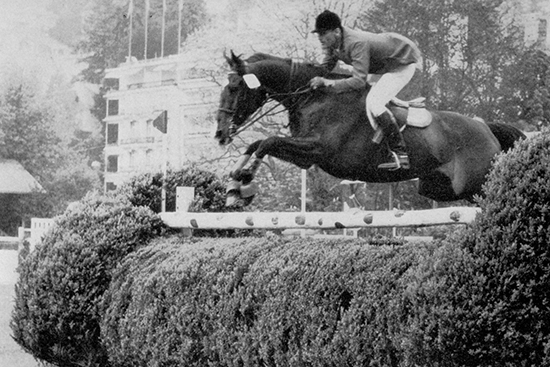
Story by Christopher Hector and Photos by Roz Neave
By day three, the riders were well and truly into the swing of George’s system, and it was quite extraordinary to witness the transformation of both horse and rider. I guess what happens a lot of the time is that the instructor asks the rider to assume a correct position, asks a couple of times more, then gives up – the rider leaves the lesson no better off than when he or she started. Mr Morris doesn’t just ask, he DEMANDS, and he keeps on demanding until he gets the desired result. Student leaves clinic having actually learnt something. Amazing.
With the horses the process is much the same. On one level, George is insisting that they be ridden correctly and tactfully, but on another level, he has this witchy ability to set up exercises and build tracks, that change the horse’s shape in the air. Incredible.
For all the insistence on classical dressage, at the end of the day, as George emphasizes, this is a jumping clinic not a dressage clinic and looking pretty is not good enough:
“You look very nice, very pretty, but you have to oil your brains, the clock is ticking, Lamaze and Pessoa, they don’t have time faults because they are used to working at pace. I love dressage, I worship classical dressage, but this is not a dressage clinic, it is a jumping clinic. The ‘cluck’ is a super aid, when the spur or the stick is too strong.”
“Hilary, if you take, take, you won’t see a distance, ease off and see a distance…”
Once again, George was using his reverse half turn, this time with a vertical to an oxer, 59’ feet, a foot short of four strides, and George wanted the riders to do it in five…
“Four is not an option, it has to be five – that’s it Danni, that’s the best you have done, you went with the horse to that deep spot. Let the horse go forward, what will set the horse back is the fence.”
George put the fences up four holes, and this time he wanted the riders to go up in four, back in five, then up in five and back in four.
“There are lots of reins in riding but the best for jumping is the leading rein – it goes out and down and doesn’t interfere with the bascule but it keeps the horse straight and it gets the turn to the jump. Now George wanted them jumping the Liverpool with him waving left or right after the jump to get an instant reaction.
And of course, George wants to put the exercise into practice… over the vertical, round the corner to the wall, six or seven to the Liverpool, then a compulsory five back to the first vertical.
Then to really test that opening rein, the George added another vertical, with a track that at first took the combination outside the triple bar, but wound tighter, to go inside the triple, in a progressively smaller figure of eight.
Then in a progressively smaller figure of eight…
“This exercise gets the horse straight but also super soft in his mouth. I saw something like this on one of Leopoldo’s (Palacios) courses, and everyone did six in the first round – do seven and you have a time fault. Come on Amanda this exercise will get your hard headed hussy, soft. Just a little tip is all I can offer, and a light comes on, a feel comes on.”
“This is a Frank Rothenberger treble: triple bar, 35 to a wide oxer, and 24 to a vertical. Most of them hit the back rail of the oxer when they see the spooky vertical.”
Just when you think George must be running out of exercises, another comes along…
George had the riders jump a vertical at right angles to the wide oxer, turn tight left come between the oxer and the vertical, back round and over the triple bar, then the oxer, vertical, curve right seven strides over the wall, hard turn left and stop.
George keeps putting up the fences and you are aware once again how clever the teacher is, he has built what is virtually a major European track with just a couple of fences. And a track that really tests the accuracy of the riding:
“Bill Steinkraus (below) was the master of this sort of riding, his hands were so delicate and giving in the turns.”
Hilary has the first vertical on Pro Ratina: “Stop. They are anticipating the turns. Jump straight, stay straight a few strides, then turn.”
This time the mare does it very well, but George doesn’t like the eight strides to the last – “do it in seven…”
With Jamie Kermond, George saw that Lincoln was anticipating the left turn on the last element, the wall, once again, the solution is simple, turn right. And once again, Danni Butcher drew praise for her riding: “That’s it Danni, that is the great principle, give and take, not just take.”
Even the cool down hides a lesson:
“Lengthen your stirrups to riding length, and take your feet out of the stirrups. John Whitaker is the icon of 20th century jumping, he is the best of all. Watch him walk to the in-gate, he takes his feet out of the irons to lengthen his legs, so when he picks up the stirrup, it feels shorter for the competition.”
“Let them walk, let the horse stretch, but make sure they are still active behind.”
This article first appeared in the April 2011 issue of THM.


